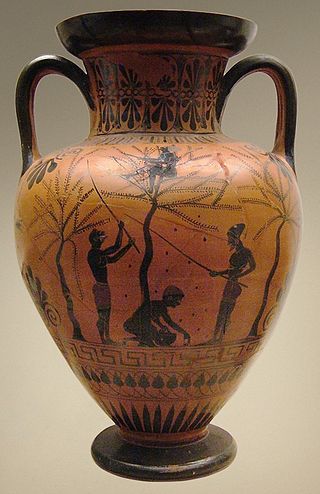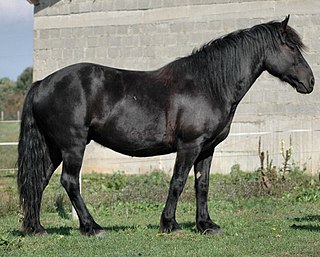The 14th century BC was the century that lasted from the year 1400 BC until 1301 BC.
On Horsemanship is the English title usually given to Περὶ ἱππικῆς, peri hippikēs, one of the two treatises on horsemanship by the Athenian historian and soldier Xenophon. Other common titles for this work are De equis alendis and The Art of Horsemanship. The other work by Xenophon on horsemanship is Ἱππαρχικὸς, hipparchikos, usually known as Hipparchicus, or The cavalry commander. The title De re equestri may refer to either of the two.

The Pindos is breed of pony or small horse native to the Pindus mountain range in Thessaly and Epirus in Greece. It is also present in mountainous parts of Thrace and Macedonia. There is a feral herd near Neochori, Karditsa, close to Lake Plastiras.

Agriculture was the foundation of the Ancient Greek economy. Nearly 80% of the population was involved in this activity.

Jean-Pierre Vernant was a French resistant, historian and anthropologist, specialist in ancient Greece. Influenced by Claude Lévi-Strauss, Vernant developed a structuralist approach to Greek myth, tragedy, and society which would itself be influential among classical scholars. He was an honorary professor at the Collège de France.

The Mérens, Cheval de Mérens or Caballo de Merens, still occasionally referred to by the older name of Ariégeois pony, is a small, rustic horse native to the Pyrenees and Ariégeois mountains of southern France, where the river Ariège flows, and northern Spain, near Andorra. Two general types, a small, light traditional mountain horse and a taller, sportier modern type, are found. Always black in color, Mérens must meet strict physical standards in order to be registered in the stud book. The breed is known for its sure-footedness on mountain terrain, as well as for its endurance, hardiness and docility. The French breed registry organizes regional offices, and partners with other national organizations in Europe to preserve and promote the breed. The organization enforces rigorous selection of breeding stock, with a goal of increasing quality in the breed. In the past, the Mérens was used for farm work, draft work and as pack horses. Today it is mainly used as a saddle horse, although some members of the breed have been successful in carriage driving. Many Mérens are taken on an annual transhumance, in which they are moved higher in the mountains during the summer and into the valleys for the winter. An old practice, it fell into disfavor, but has recently re-emerged.

Orestis was a region of Upper Macedonia, corresponding roughly to the modern Kastoria regional unit located in West Macedonia, Greece. Its inhabitants were the Orestae, an ancient Greek tribe that was part of the Molossian tribal state or koinon.
Atintanes or Atintanians was an ancient tribe that dwelled in the borderlands between Epirus and Illyria, in an inland region which was called Atintania. They have been described as either an Epirote tribe that belonged to the northwestern Greek group, or as an Illyrian tribe. They were occasionally subordinate to the Molossians.
Claude Calame is a Swiss writer on Greek mythology and the structure of mythic narrative from the perspective of a Hellenist trained in semiotics and ethnology (ethnopoetics) as well as philology. He was a professor of Greek language and literature at the University of Lausanne and is now Director of Studies at the School for Advanced Studies in the Social Sciences, in Paris. He taught also at the Universities of Urbino and Siena in Italy, and at Yale University in the US.
Hipparchicus is one of the two treatises on horsemanship by the Athenian historian and soldier Xenophon (circa 430 – 354 BC). Other common titles for this work include The cavalry commander and The cavalry general. The other work by Xenophon on horsemanship is Περὶ ἱππικῆς, Perì hippikēs, usually translated as On horsemanship, De equis alendis or The Art of Horsemanship. The title De re equestri may refer to either one of the two works. Hipparchicus deals mainly with the duties of the cavalry commander (hipparchus), while On horsemanship deals with the selection, care and training of horses in general.
Claude Mossé was a French historian specializing in the history of Ancient Greece.

Léon-Maxime Collignon was a French archaeologist who specialized in ancient Greek art and architecture.
Simon of Athens was an Athenian writer on horses and horsemanship of the fifth century BC. He is the earliest known ancient Greek writer on the subject; Pliny described him as primus de equitatu scripsit, "the first to have written on riding". His writings are quoted by Xenophon.
The M'Par or Mpar is a breed of small horse from the historic region of Cayor in Senegal, in West Africa. It may for that reason be called the French: Cheval de Cayor. It is the smallest of the four Senegalese horse breeds, the others being the M'Bayar, the Fleuve and the Foutanké.
Michel Debidour is a French historian and archaeologist.
Roland Martin was a French archaeologist.
Claude Rolley was a French archaeologist, emeritus at the University of Burgundy, writer on art, archaeology of Greece and Gaule.
Pierre Lévêque was a 20th-century French historian of ancient and Hellenistic Greece.
Marie-Françoise Baslez was a French historian and academic. She specialized in Hellenistic Judaism and primitive Christianity and the persecution faced by the two religious groups.

The Zakynthos is a breed of generally black saddle and combined driving horses originating from the island of Zante, one of the Ionian Islands, in Greece. The origin of this breed is very recent, dating back to the 20th century. This breed is of Anglo-Arabian type and is genetically close to the Andravida. Genetic analysis shows that it has been crossed with the Thoroughbred. The Zakynthos may also be descended from the Nivernais-type Percheron. Its type remains unstable, and the breed has no official standards or identification documents.







